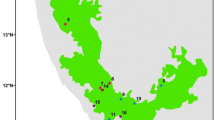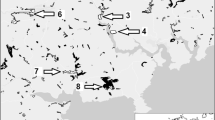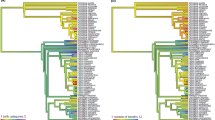Abstract
Macaques are found both in broadleaf evergreen forest and in more variable habitats. The former group might be expected to be subject to less variability in their environment and hence to suffer lower rates of density independent mortality. Life history evolution models predict that species in such conditions will have lower rates of development and breeding than those found in more variable habitats where density independent mortality is high. This prediction is tested here by comparing the breeding and development rates of nine species of macaque. Although measures of developmental rate are not found to vary in a predictable way with habitat, measures of breeding rate do correlate with habitat categories used. As predicted, species that are found in more variable habitats tend to have higher birth rates and a higher intrinsic rate of natural increase than do species in more stable, forest habitats. Contrary to prediction selection does not always act to produce an early age at first reproduction in macaques living in seasonal environments. This is discussed with relation to physiological and environmental constraints.
Similar content being viewed by others
References
Berkson, G., 1968. Weight and tooth development during the first year inMacaca irus.Lab. Anim. Care, 18: 352–355.
Bourne, G. H., 1975.The Rhesus Monkey. Vol. 1. Academic Press, London & New York.
Boyce, M. S., 1984. Restitution ofr- andK-selection as a model of density-dependent natural selection.Ann. Rev. Ecol. Syst., 15: 427–447.
Cole, L. C., 1954. The population consequences of life history phenomena.Quart. Rev Biol., 29: 103–137.
Dittus, W. P. J., 1975. Population dynamics of the toque monkey,Macaca sinica. In:Socioecology and Psychology of Primates.R. H. Tuttle (ed.), Mouton, The Hague, pp. 125–151.
Faucheux, B., M. Bertrand, &F. Bourlièr, 1978. Some effects of living conditions on the pattern of growth in stumptail macaque (Macaca arctiodes).Folia Primatol., 30: 220–236.
Fooden, J., 1980. Classification and distribution of living macaques (Macaca Lacépède, 1799). In:The Macaques: Studies in Ecology, Behavior and Evolution.D. G. Lindburg (ed.), Van Nostrand Reinhold, New York, pp. 1–9.
————, 1982. Ecogeographic separation of macaque species.Primates, 23: 574–579.
————, 1990. The bear macaque,Macaca arctiodes: a systematic review.J. Human Evol., 19: 607–686.
Groves, C. P., 1980. Speciation inMacaca: the view from Sulawesi. In:The Macaques: Studies in Ecology, Behavior and Evolution.D.G. Lindburg (ed.), Van Nostrand Reinhold, New York, pp. 84–124.
Hadidian, J. &I. S. Bernstein, 1979. Female reproductive cycles and birth data from an Old World monkey colony.Primates, 20: 429–442.
Harvey, N. C. &R. J. Rhine, 1983. Some reproductive characters of stumptailed macaques (Macaca arctiodes).Primates, 24: 530–536.
Harvey, P. H. &T. H. Clutton-Brock, 1977. Primate ecology and social organization.J. Zool. London, 183: 1–39.
———— &G. M. Mace, 1982. Comparisons between taxa and adaptive trends: a problem of methodology. In:Current Trends in Sociobiology.King's College Sociobiology Group (eds.), Cambridge Univ. Press, Cambridge, pp. 343–362.
————,R. D. Martin, &T. H. Clutton-Brock, 1987. Life histories in comparative perspective. In:Primate Societies.B. B. Smuts, D. L. Cheney, R. M. Seyfarth, R. W. Wrangham, &T. T. Struhsaker (eds.), Univ. of Chicago Press, Chicago & London, pp. 181–196.
Hayssen, V., 1984. Basal metabolic rate and the intrinsic rate of natural increase: an empirical and theoretical reexamination.Oecologia (Berlin), 64: 419–424.
Hennemann, W. W. III., 1983. Relationship among body mass, metabolic rate and the intrinsic rate of natural increase in mammals.Oecologia (Berlin), 56: 419–424.
————, 1984. Basal metabolic rate and the intrinsic rate of natural increase: an empirical and theoretical reexamination.Oecologia (Berlin), 64: 421–423.
Jones, M. L., 1968. Longevity of primates in captivity.Int. Zoo Ybk, 8: 183–193.
Lindberg, D. G. &B. L. Lasley, 1985. Strategies for optimising the reproductive potential of lion-tailed macaque colonies in captivity. In:The Lion-tailed Macaque: Status and Conservation.P. G. Heltne (ed.), Alan R. Liss, New York, pp. 343–356.
Loy, J., 1988. Effects of supplementary feeding on maturation and fertility in primate groups. In:Ecology and Behaviour of Food-enhanced Primate Groups.J. E. Fa &C. H. Southwick (eds.), Alan R. Liss, New York, pp. 153–166.
Martin, R. D. &A. M. MacLarnon, 1988. Comparative quantitative studies of growth and reproduction.Symposia of the Zool. Soc. London, 60: 39–80.
Masui, K., Y. Sugiyama, A. Nishimura, &H. Ohsawa, 1975. The life table of Japanese monkeys at Takasakiyama. In:Contemporary Primatology: Fifth International Congress of Primatology, Nagoya 1974.S. Kondo, M. Kawai, &A. Ehara (eds.), S. Karger, Basel, pp. 401–406.
Melnick, D. J. &M. C. Pearl, 1987. Cercopithecines in multi-male groups: Genetic diversity and population structure. In:Primate Societies.B. B. Smuts, D. L. Cheney, R. M. Seyfarth, R. W. Wrangham, &T. T. Struhsaker (eds.), Univ. of Chicago Press, Chicago & London, pp. 121–134.
Mori, A., 1979. Analysis of population changes by measurement of body weight in the Koshima troop of Japanese monkeys.Primates, 20: 371–391.
Nigi, H., 1976. Some aspects related to conception in the Japanese monkey (Macaca fuscata),Primates, 17: 81–87.
Nomura, T., N. Ohsawa, Y. Tajima, T. Tanaka, S. Kotera, A. Ando, & H. Nigi, 1971. Reproduction of Japanese monkeys. In:Acta Endocrinologica: WHO symposium on the use of non-human primates for research on problems of human reproduction, Sukhumi, U.S.S.R., pp. 473–482.
Ohno, T., Y. Kato, &K. Myoga, 1980. Growth performance and weight change of Japanese macaques under laboratory conditions.Nutrition Reports Int., 22: 935–938.
Paul, A. &D. Thommen, 1984. Timing of birth, female reproductive success and infant sex ratio in semifree-ranging barbary macaques (Macaca sylvanus).Folia Primatol., 42: 2–16.
Rawlins, R. G., M. J. Kessler, &J. E. Turnquist, 1984. Reproductive performance, population-dynamics and anthropometrics of the free-ranging Cayo Santiago rhesus macaques.J. Med. Primatol., 13: 247–259.
Roberts, M. S., 1978. The annual reproductive cycle of captiveMacaca sylvanus.Folia Primatol., 29: 229–235.
Rosenblum, L. A. &J. Smiley, 1980. Weight gain in bonnet and pigtail macaques.J. Med. Primatol., 9: 247–253.
Ross, C., 1988. The intrinsic rate of natural increase and reproductive effort in primates.J. Zool. London, 214: 199–219.
----, 1989. Life history strategies of primates. Unpubl. Ph.D. thesis, Univ. of London.
————, 1991. Life-history patterns of New World monkeys.Int. J. Primatol., 12: 481–502.
Rowell, T. E. &J. M. Richards, 1979. Reproductive strategies of some African monkeys.J. Mammal., 60: 58–69.
Sackett, G. P., R. A. Holm, &C. E. Fahrenbruch, 1979. Ponderal growth in a colony and nursery-reared pigtail macaques (Macaca nemestrina). In:Nursery Care of Non-human Primates.G. C. Ruppenthal (ed.), Plenum, New York & London, pp. 187–201.
Scucchi, S., 1984. Interbirth intervals in a group of Japanese macaques (Macaca fuscata).Folia Primatol., 42: 203–209.
Silk, J. B., 1988. Social mechanisms of population regulation in a captive group of bonnet macaques (Macaca radiata).Amer. J. Primatol., 14: 111–124.
————, 1990. Sources of variation in interbirth intervals among captive bonnet macaques (Macaca radiata).Amer. J. Phys. Anthropol., 82: 213–230.
Stearns, S. C., 1976. Life-history tactics: a review of the ideas.Quart. Rev. Biol., 51: 3–47.
————, 1977. The evolution of life-history traits: a critique of the theory and a review of the data.Ann. Rev. Ecol. Syst., 8: 145–171.
Sugiyama, Y. &H. Ohsawa, 1982. Population dynamics of Japanese monkeys with special reference to the effect of artificial feeding.Folia Primatol., 39: 238–263.
Takahata, Y., 1980. The reproductive biology of a free-ranging troop of Japanese monkeys.Primates, 21: 303–329.
van Wagenen, G. &H. R. Catchpole, 1956. Physical growth of the rhesus monkey (Macaca mulatta).Amer. J. Phys. Anthropol., 14: 245–273.
Wolfe, L. D., 1986. Reproductive biology of Rhesus and Japanese macaques.Primates, 27: 95–101.
Author information
Authors and Affiliations
About this article
Cite this article
Ross, C. Life history patterns and ecology of macaque species. Primates 33, 207–215 (1992). https://doi.org/10.1007/BF02382750
Received:
Accepted:
Issue Date:
DOI: https://doi.org/10.1007/BF02382750




